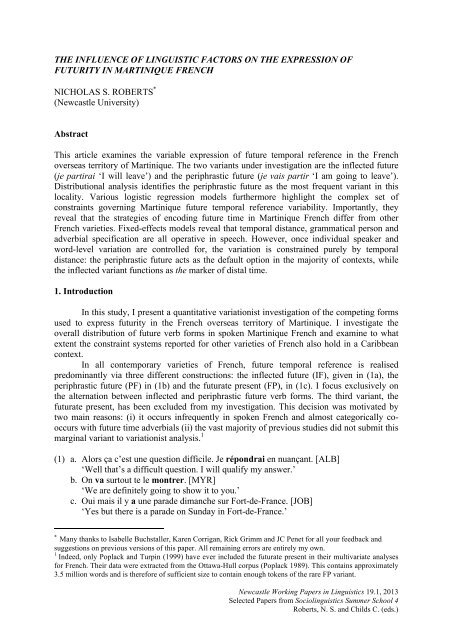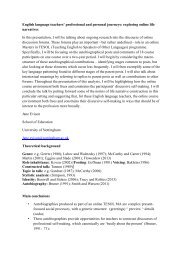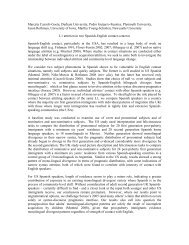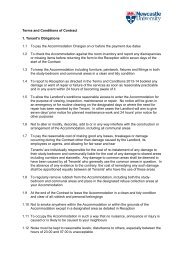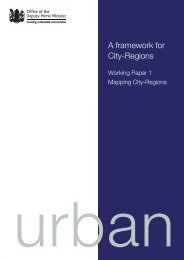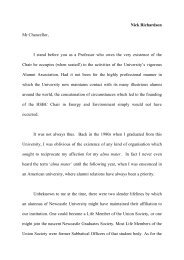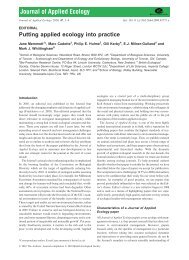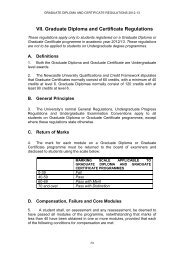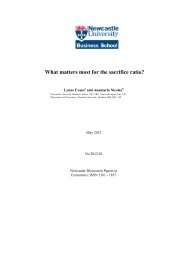the influence of linguistic factors on the expression of futurity
the influence of linguistic factors on the expression of futurity
the influence of linguistic factors on the expression of futurity
You also want an ePaper? Increase the reach of your titles
YUMPU automatically turns print PDFs into web optimized ePapers that Google loves.
THE INFLUENCE OF LINGUISTIC FACTORS ON THE EXPRESSION OF<br />
FUTURITY IN MARTINIQUE FRENCH<br />
NICHOLAS S. ROBERTS *<br />
(Newcastle University)<br />
Abstract<br />
This article examines <str<strong>on</strong>g>the</str<strong>on</strong>g> variable expressi<strong>on</strong> <str<strong>on</strong>g>of</str<strong>on</strong>g> future temporal reference in <str<strong>on</strong>g>the</str<strong>on</strong>g> French<br />
overseas territory <str<strong>on</strong>g>of</str<strong>on</strong>g> Martinique. The two variants under investigati<strong>on</strong> are <str<strong>on</strong>g>the</str<strong>on</strong>g> inflected future<br />
(je partirai ‘I will leave’) and <str<strong>on</strong>g>the</str<strong>on</strong>g> periphrastic future (je vais partir ‘I am going to leave’).<br />
Distributi<strong>on</strong>al analysis identifies <str<strong>on</strong>g>the</str<strong>on</strong>g> periphrastic future as <str<strong>on</strong>g>the</str<strong>on</strong>g> most frequent variant in this<br />
locality. Various logistic regressi<strong>on</strong> models fur<str<strong>on</strong>g>the</str<strong>on</strong>g>rmore highlight <str<strong>on</strong>g>the</str<strong>on</strong>g> complex set <str<strong>on</strong>g>of</str<strong>on</strong>g><br />
c<strong>on</strong>straints governing Martinique future temporal reference variability. Importantly, <str<strong>on</strong>g>the</str<strong>on</strong>g>y<br />
reveal that <str<strong>on</strong>g>the</str<strong>on</strong>g> strategies <str<strong>on</strong>g>of</str<strong>on</strong>g> encoding future time in Martinique French differ from o<str<strong>on</strong>g>the</str<strong>on</strong>g>r<br />
French varieties. Fixed-effects models reveal that temporal distance, grammatical pers<strong>on</strong> and<br />
adverbial specificati<strong>on</strong> are all operative in speech. However, <strong>on</strong>ce individual speaker and<br />
word-level variati<strong>on</strong> are c<strong>on</strong>trolled for, <str<strong>on</strong>g>the</str<strong>on</strong>g> variati<strong>on</strong> is c<strong>on</strong>strained purely by temporal<br />
distance: <str<strong>on</strong>g>the</str<strong>on</strong>g> periphrastic future acts as <str<strong>on</strong>g>the</str<strong>on</strong>g> default opti<strong>on</strong> in <str<strong>on</strong>g>the</str<strong>on</strong>g> majority <str<strong>on</strong>g>of</str<strong>on</strong>g> c<strong>on</strong>texts, while<br />
<str<strong>on</strong>g>the</str<strong>on</strong>g> inflected variant functi<strong>on</strong>s as <str<strong>on</strong>g>the</str<strong>on</strong>g> marker <str<strong>on</strong>g>of</str<strong>on</strong>g> distal time.<br />
1. Introducti<strong>on</strong><br />
In this study, I present a quantitative variati<strong>on</strong>ist investigati<strong>on</strong> <str<strong>on</strong>g>of</str<strong>on</strong>g> <str<strong>on</strong>g>the</str<strong>on</strong>g> competing forms<br />
used to express <strong>futurity</strong> in <str<strong>on</strong>g>the</str<strong>on</strong>g> French overseas territory <str<strong>on</strong>g>of</str<strong>on</strong>g> Martinique. I investigate <str<strong>on</strong>g>the</str<strong>on</strong>g><br />
overall distributi<strong>on</strong> <str<strong>on</strong>g>of</str<strong>on</strong>g> future verb forms in spoken Martinique French and examine to what<br />
extent <str<strong>on</strong>g>the</str<strong>on</strong>g> c<strong>on</strong>straint systems reported for o<str<strong>on</strong>g>the</str<strong>on</strong>g>r varieties <str<strong>on</strong>g>of</str<strong>on</strong>g> French also hold in a Caribbean<br />
c<strong>on</strong>text.<br />
In all c<strong>on</strong>temporary varieties <str<strong>on</strong>g>of</str<strong>on</strong>g> French, future temporal reference is realised<br />
predominantly via three different c<strong>on</strong>structi<strong>on</strong>s: <str<strong>on</strong>g>the</str<strong>on</strong>g> inflected future (IF), given in (1a), <str<strong>on</strong>g>the</str<strong>on</strong>g><br />
periphrastic future (PF) in (1b) and <str<strong>on</strong>g>the</str<strong>on</strong>g> futurate present (FP), in (1c). I focus exclusively <strong>on</strong><br />
<str<strong>on</strong>g>the</str<strong>on</strong>g> alternati<strong>on</strong> between inflected and periphrastic future verb forms. The third variant, <str<strong>on</strong>g>the</str<strong>on</strong>g><br />
futurate present, has been excluded from my investigati<strong>on</strong>. This decisi<strong>on</strong> was motivated by<br />
two main reas<strong>on</strong>s: (i) it occurs infrequently in spoken French and almost categorically cooccurs<br />
with future time adverbials (ii) <str<strong>on</strong>g>the</str<strong>on</strong>g> vast majority <str<strong>on</strong>g>of</str<strong>on</strong>g> previous studies did not submit this<br />
marginal variant to variati<strong>on</strong>ist analysis. 1<br />
(1) a. Alors ça c’est une questi<strong>on</strong> difficile. Je rép<strong>on</strong>drai en nuançant. [ALB]<br />
‘Well that’s a difficult questi<strong>on</strong>. I will qualify my answer.’<br />
b. On va surtout te le m<strong>on</strong>trer. [MYR]<br />
‘We are definitely going to show it to you.’<br />
c. Oui mais il y a une parade dimanche sur Fort-de-France. [JOB]<br />
‘Yes but <str<strong>on</strong>g>the</str<strong>on</strong>g>re is a parade <strong>on</strong> Sunday in Fort-de-France.’<br />
* Many thanks to Isabelle Buchstaller, Karen Corrigan, Rick Grimm and JC Penet for all your feedback and<br />
suggesti<strong>on</strong>s <strong>on</strong> previous versi<strong>on</strong>s <str<strong>on</strong>g>of</str<strong>on</strong>g> this paper. All remaining errors are entirely my own. <br />
1 Indeed, <strong>on</strong>ly Poplack and Turpin (1999) have ever included <str<strong>on</strong>g>the</str<strong>on</strong>g> futurate present in <str<strong>on</strong>g>the</str<strong>on</strong>g>ir multivariate analyses<br />
for French. Their data were extracted from <str<strong>on</strong>g>the</str<strong>on</strong>g> Ottawa-Hull corpus (Poplack 1989). This c<strong>on</strong>tains approximately<br />
3.5 milli<strong>on</strong> words and is <str<strong>on</strong>g>the</str<strong>on</strong>g>refore <str<strong>on</strong>g>of</str<strong>on</strong>g> sufficient size to c<strong>on</strong>tain enough tokens <str<strong>on</strong>g>of</str<strong>on</strong>g> <str<strong>on</strong>g>the</str<strong>on</strong>g> rare FP variant.<br />
Newcastle Working Papers in Linguistics 19.1, 2013<br />
Selected Papers from Socio<str<strong>on</strong>g>linguistic</str<strong>on</strong>g>s Summer School 4<br />
Roberts, N. S. and Childs C. (eds.)
THE EXPRESSION OF FUTURITY IN MARTINIQUE FRENCH 139<br />
2. Previous studies<br />
For both prescriptive and pedagogical grammars, <str<strong>on</strong>g>the</str<strong>on</strong>g> two main <str<strong>on</strong>g>linguistic</str<strong>on</strong>g> <str<strong>on</strong>g>factors</str<strong>on</strong>g><br />
governing variant choice are (a) <str<strong>on</strong>g>the</str<strong>on</strong>g> temporal distance between speech time and <str<strong>on</strong>g>the</str<strong>on</strong>g> future<br />
eventuality and (b) <str<strong>on</strong>g>the</str<strong>on</strong>g> degree <str<strong>on</strong>g>of</str<strong>on</strong>g> certainty that <str<strong>on</strong>g>the</str<strong>on</strong>g> future event will in fact take place (cf.<br />
Poplack & Di<strong>on</strong> 2009: 561–9). The periphrastic future, for instance, has been claimed to mark<br />
‘<str<strong>on</strong>g>of</str<strong>on</strong>g>ten a near future but also sometimes a relatively distal <strong>on</strong>e that is c<strong>on</strong>sidered unavoidable’<br />
(my translati<strong>on</strong>, Grevisse & Goosse 1993: 1230). Thus, according to Hawkins and Towell<br />
(2001: 228–9), <str<strong>on</strong>g>the</str<strong>on</strong>g> selecti<strong>on</strong> <str<strong>on</strong>g>of</str<strong>on</strong>g> <str<strong>on</strong>g>the</str<strong>on</strong>g> inflected variant in (2a) renders <str<strong>on</strong>g>the</str<strong>on</strong>g> utterance as purely<br />
hypo<str<strong>on</strong>g>the</str<strong>on</strong>g>tical, i.e. she is currently not pregnant but would like to have a baby in <str<strong>on</strong>g>the</str<strong>on</strong>g> future. In<br />
c<strong>on</strong>trast, <str<strong>on</strong>g>the</str<strong>on</strong>g> choice <str<strong>on</strong>g>of</str<strong>on</strong>g> <str<strong>on</strong>g>the</str<strong>on</strong>g> periphrastic c<strong>on</strong>structi<strong>on</strong> in (2b) indicates that her utterance is<br />
justified, i.e. she is pregnant and will give birth.<br />
(2) a. Elle aura un bébé.<br />
‘She will have a baby.’<br />
b. Elle va avoir un bébé.<br />
‘She is going to have a baby.’<br />
(Hawkins & Towell 2001: 229)<br />
Labovian socio<str<strong>on</strong>g>linguistic</str<strong>on</strong>g> studies have tested <str<strong>on</strong>g>the</str<strong>on</strong>g>se claims quantitatively using corpora<br />
<str<strong>on</strong>g>of</str<strong>on</strong>g> speech data. Thus far, we have evidence from Laurentian (Deshaies & Laforge 1981,<br />
Emirkanian & D. Sank<str<strong>on</strong>g>of</str<strong>on</strong>g>f 1985, Zimmer 1994, Poplack & Turpin 1999, Bl<strong>on</strong>deau 2006,<br />
Poplack & Di<strong>on</strong> 2009, Grimm 2010, Grimm & Nadasdi 2011, Wagner & G. Sank<str<strong>on</strong>g>of</str<strong>on</strong>g>f 2011, G.<br />
Sank<str<strong>on</strong>g>of</str<strong>on</strong>g>f, Wagner & Jensen 2012) and Acadian (Chevalier 1996, King & Nadasdi 2003,<br />
Comeau 2011) varieties <str<strong>on</strong>g>of</str<strong>on</strong>g> Canadian French, 2 as well as European French (Söll 1983, Roberts<br />
2012).<br />
These studies have dem<strong>on</strong>strated that, c<strong>on</strong>trary to <str<strong>on</strong>g>the</str<strong>on</strong>g> prescriptive literature, a range <str<strong>on</strong>g>of</str<strong>on</strong>g><br />
<str<strong>on</strong>g>linguistic</str<strong>on</strong>g> <str<strong>on</strong>g>factors</str<strong>on</strong>g> c<strong>on</strong>diti<strong>on</strong> <str<strong>on</strong>g>the</str<strong>on</strong>g> choice <str<strong>on</strong>g>of</str<strong>on</strong>g> future variants in <str<strong>on</strong>g>the</str<strong>on</strong>g> French language (see secti<strong>on</strong><br />
3.2). Fur<str<strong>on</strong>g>the</str<strong>on</strong>g>rmore, <str<strong>on</strong>g>the</str<strong>on</strong>g>y have shown that, in speech, <str<strong>on</strong>g>the</str<strong>on</strong>g>re exists a preference for periphrastic<br />
verbs forms, irrespective <str<strong>on</strong>g>of</str<strong>on</strong>g> <str<strong>on</strong>g>the</str<strong>on</strong>g> variety under c<strong>on</strong>siderati<strong>on</strong>. In Laurentian French, <str<strong>on</strong>g>the</str<strong>on</strong>g><br />
frequency <str<strong>on</strong>g>of</str<strong>on</strong>g> inflected forms is reported to range from <strong>on</strong>ly 11% (N=135) in Ontarian French<br />
(Grimm & Nadasdi 2011: 181) to 22% (N=725) in Ottawa-Hull (Poplack & Turpin 1999:<br />
148). 3 In c<strong>on</strong>trast, <str<strong>on</strong>g>the</str<strong>on</strong>g>re is a greater prevalence <str<strong>on</strong>g>of</str<strong>on</strong>g> <str<strong>on</strong>g>the</str<strong>on</strong>g> IF (41%, N=179) in European French<br />
(Roberts 2012: 101) and <str<strong>on</strong>g>the</str<strong>on</strong>g> more c<strong>on</strong>servative Acadian varieties: IF usage rates vary from<br />
38% (N=257) in Baie-Sainte Marie, Nova Scotia (Comeau 2011: 226) to 53% (N=362) in<br />
Prince Edward Island and Newfoundland (King & Nadasdi 2003: 332).<br />
The overall variant distributi<strong>on</strong> detailed above is, however, in stark c<strong>on</strong>trast to written<br />
language studies, which show a reversal <str<strong>on</strong>g>of</str<strong>on</strong>g> this general trend. Lesage and Gagn<strong>on</strong> (1993) and<br />
Wales (2002) report that <str<strong>on</strong>g>the</str<strong>on</strong>g> incidence <str<strong>on</strong>g>of</str<strong>on</strong>g> IF forms far exceeds that <str<strong>on</strong>g>of</str<strong>on</strong>g> <str<strong>on</strong>g>the</str<strong>on</strong>g> periphrastic future<br />
in <str<strong>on</strong>g>the</str<strong>on</strong>g>ir respective journalistic corpora. Indeed, <str<strong>on</strong>g>the</str<strong>on</strong>g> relative frequency <str<strong>on</strong>g>of</str<strong>on</strong>g> <str<strong>on</strong>g>the</str<strong>on</strong>g> two variants in<br />
Lesage and Gagn<strong>on</strong>’s Québec French dataset was 97% (N=5,818) for <str<strong>on</strong>g>the</str<strong>on</strong>g> IF and <strong>on</strong>ly 3% for<br />
<str<strong>on</strong>g>the</str<strong>on</strong>g> PF (N=199), while Wales reports almost identical results in his Ouest-France regi<strong>on</strong>al<br />
newspaper study (IF: 90%, N=7,751; PF: 10%, N=887).<br />
2 The term ‘Laurentian French’ denotes varieties genetically related to Québec French (e.g. in Canadian<br />
provinces west <str<strong>on</strong>g>of</str<strong>on</strong>g> Québec and in <str<strong>on</strong>g>the</str<strong>on</strong>g> Nor<str<strong>on</strong>g>the</str<strong>on</strong>g>ast United States). ‘Acadian French’ refers to those varieties spoken<br />
in <str<strong>on</strong>g>the</str<strong>on</strong>g> four Atlantic provinces <str<strong>on</strong>g>of</str<strong>on</strong>g> New Brunswick, Newfoundland, Nova Scotia and Prince Edward Island.<br />
3 The percentage scores for Poplack and Turpin (1999) have been recalculated to exclude <str<strong>on</strong>g>the</str<strong>on</strong>g> futurate present.
140<br />
NICHOLAS S. ROBERTS<br />
3. Data and methodology<br />
The data for <str<strong>on</strong>g>the</str<strong>on</strong>g> present study were extracted from a corpus <str<strong>on</strong>g>of</str<strong>on</strong>g> spoken Martinique<br />
French. The island <str<strong>on</strong>g>of</str<strong>on</strong>g> Martinique has a populati<strong>on</strong> <str<strong>on</strong>g>of</str<strong>on</strong>g> nearly 400,000 people (IEDOM 2010:<br />
24) and is situated in <str<strong>on</strong>g>the</str<strong>on</strong>g> Lesser Antilles archipelago between <str<strong>on</strong>g>the</str<strong>on</strong>g> islands <str<strong>on</strong>g>of</str<strong>on</strong>g> Dominica to <str<strong>on</strong>g>the</str<strong>on</strong>g><br />
North and Saint Lucia to <str<strong>on</strong>g>the</str<strong>on</strong>g> South. Although <str<strong>on</strong>g>the</str<strong>on</strong>g> vast majority <str<strong>on</strong>g>of</str<strong>on</strong>g> English-speaking islands<br />
gained <str<strong>on</strong>g>the</str<strong>on</strong>g>ir independence in <str<strong>on</strong>g>the</str<strong>on</strong>g> latter part <str<strong>on</strong>g>of</str<strong>on</strong>g> <str<strong>on</strong>g>the</str<strong>on</strong>g> 20 th century, Martinique still remains an<br />
integral part <str<strong>on</strong>g>of</str<strong>on</strong>g> <str<strong>on</strong>g>the</str<strong>on</strong>g> French Republic as a département et régi<strong>on</strong> d’outre-mer ‘m<strong>on</strong>odepartmental<br />
overseas territory’, even though it is located approximately 7,000 km from<br />
mainland France.<br />
The corpus comprises approximately 16 hours <str<strong>on</strong>g>of</str<strong>on</strong>g> semi-directed interviews c<strong>on</strong>ducted<br />
by me between December 2011 and February 2012. In order to minimise <str<strong>on</strong>g>the</str<strong>on</strong>g> effects <str<strong>on</strong>g>of</str<strong>on</strong>g> <str<strong>on</strong>g>the</str<strong>on</strong>g><br />
observer’s paradox, participants were recorded in self-selected dyads. Fur<str<strong>on</strong>g>the</str<strong>on</strong>g>rmore, <str<strong>on</strong>g>the</str<strong>on</strong>g> topics<br />
covered during <str<strong>on</strong>g>the</str<strong>on</strong>g> course <str<strong>on</strong>g>of</str<strong>on</strong>g> <str<strong>on</strong>g>the</str<strong>on</strong>g> recordings were based <strong>on</strong> <str<strong>on</strong>g>the</str<strong>on</strong>g> modules found in a traditi<strong>on</strong>al<br />
socio<str<strong>on</strong>g>linguistic</str<strong>on</strong>g> interview (Labov 1972) but were tailored to community-specific issues and<br />
traditi<strong>on</strong>s (cf. Meyerh<str<strong>on</strong>g>of</str<strong>on</strong>g>f & Walker 2007). The analysis is based <strong>on</strong> a judgment sample <str<strong>on</strong>g>of</str<strong>on</strong>g> 32<br />
informants, all <str<strong>on</strong>g>of</str<strong>on</strong>g> whom originate from <str<strong>on</strong>g>the</str<strong>on</strong>g> Saint-Pierre arr<strong>on</strong>dissement ‘administrative<br />
district’ in <str<strong>on</strong>g>the</str<strong>on</strong>g> Northwest <str<strong>on</strong>g>of</str<strong>on</strong>g> <str<strong>on</strong>g>the</str<strong>on</strong>g> island. O<str<strong>on</strong>g>the</str<strong>on</strong>g>r than for schooling, <str<strong>on</strong>g>the</str<strong>on</strong>g>y have remained in this<br />
area for <str<strong>on</strong>g>the</str<strong>on</strong>g>ir entire lives. All <str<strong>on</strong>g>of</str<strong>on</strong>g> <str<strong>on</strong>g>the</str<strong>on</strong>g> speakers ei<str<strong>on</strong>g>the</str<strong>on</strong>g>r actively spoke, or at least had a passive<br />
knowledge <str<strong>on</strong>g>of</str<strong>on</strong>g>, <str<strong>on</strong>g>the</str<strong>on</strong>g> French-lexifier creole that is spoken <strong>on</strong> <str<strong>on</strong>g>the</str<strong>on</strong>g> island. 4 Research <strong>on</strong> bilingual<br />
Franco-Ontarian communities has shown that socio<str<strong>on</strong>g>linguistic</str<strong>on</strong>g> variables may pattern differently<br />
depending <strong>on</strong> how <str<strong>on</strong>g>of</str<strong>on</strong>g>ten speakers communicate in ei<str<strong>on</strong>g>the</str<strong>on</strong>g>r French or English. Resultantly, I<br />
decided to measure <str<strong>on</strong>g>the</str<strong>on</strong>g> frequency <str<strong>on</strong>g>of</str<strong>on</strong>g> use <str<strong>on</strong>g>of</str<strong>on</strong>g> French in interpers<strong>on</strong>al communicati<strong>on</strong> using a<br />
modified versi<strong>on</strong> <str<strong>on</strong>g>of</str<strong>on</strong>g> Mouge<strong>on</strong> and Beniak’s (1991) language-restricti<strong>on</strong> index. All <str<strong>on</strong>g>of</str<strong>on</strong>g> my<br />
informants completed a self-reported questi<strong>on</strong>naire based <strong>on</strong> a six-point scale in which <str<strong>on</strong>g>the</str<strong>on</strong>g>y<br />
rated how <str<strong>on</strong>g>of</str<strong>on</strong>g>ten <str<strong>on</strong>g>the</str<strong>on</strong>g>y communicate in both French and créole martiniquais. Questi<strong>on</strong>s focused<br />
<strong>on</strong> language use in a variety <str<strong>on</strong>g>of</str<strong>on</strong>g> settings as well as with a range <str<strong>on</strong>g>of</str<strong>on</strong>g> interlocutors. A mean score<br />
was <str<strong>on</strong>g>the</str<strong>on</strong>g>n calculated for each speaker ranging from zero (i.e. <str<strong>on</strong>g>the</str<strong>on</strong>g>y always communicate in<br />
creole) to 1 (i.e. <str<strong>on</strong>g>the</str<strong>on</strong>g>y <strong>on</strong>ly speak French).<br />
3.1. Excluded tokens<br />
I first extracted every verb form that featured IF tense morphology and every aller<br />
periphrasis from my Martinique corpus using <str<strong>on</strong>g>the</str<strong>on</strong>g> AntC<strong>on</strong>c c<strong>on</strong>cordance program (Anth<strong>on</strong>y<br />
2011). However, since <str<strong>on</strong>g>the</str<strong>on</strong>g> present study analyses variability in <str<strong>on</strong>g>the</str<strong>on</strong>g> French future temporal<br />
reference sector and not merely those verbal forms featuring future morphology, I excluded a<br />
number <str<strong>on</strong>g>of</str<strong>on</strong>g> tokens in line with <str<strong>on</strong>g>the</str<strong>on</strong>g> protocol first outlined in Poplack and Turpin (1999: 143–5).<br />
This procedure for delimiting <str<strong>on</strong>g>the</str<strong>on</strong>g> variable c<strong>on</strong>text has also been replicated and refined in<br />
more recent work (cf. Grimm & Nadasdi 2011: 174–5, Wagner & Sank<str<strong>on</strong>g>of</str<strong>on</strong>g>f 2011: 279–84).<br />
As such, it was necessary to remove all ‘false futures’. In o<str<strong>on</strong>g>the</str<strong>on</strong>g>r words, I discarded<br />
those tokens that exhibit future morphology but do not actually reference a future eventuality.<br />
As such, all habituals (3a), hypo<str<strong>on</strong>g>the</str<strong>on</strong>g>ticals (3b), instances <str<strong>on</strong>g>of</str<strong>on</strong>g> aller ‘to go’ used to indicate<br />
spatial movement (3c) and imperatives/pseudo-imperatives (3d) were not c<strong>on</strong>sidered in my<br />
quantitative analysis. It was also necessary to remove those tokens that have a future temporal<br />
reference but do not admit all <str<strong>on</strong>g>the</str<strong>on</strong>g> variants. An example <str<strong>on</strong>g>of</str<strong>on</strong>g> <str<strong>on</strong>g>the</str<strong>on</strong>g>se ‘true futures’ includes tokens<br />
occurring in <str<strong>on</strong>g>the</str<strong>on</strong>g> protases <str<strong>on</strong>g>of</str<strong>on</strong>g> c<strong>on</strong>diti<strong>on</strong>al si-clauses (3e) as such c<strong>on</strong>texts prohibit IF.<br />
4 In a recent study <str<strong>on</strong>g>of</str<strong>on</strong>g> Guadeloupe French, Pustka (2007a: 261) notes that <strong>on</strong>ly a small minority <str<strong>on</strong>g>of</str<strong>on</strong>g><br />
Guadeloupéens do not nowadays acquire French as <str<strong>on</strong>g>the</str<strong>on</strong>g>ir L1. This is also <str<strong>on</strong>g>the</str<strong>on</strong>g> case in Martinique, which has<br />
traditi<strong>on</strong>ally been viewed as more assimilated to mainland France both <str<strong>on</strong>g>linguistic</str<strong>on</strong>g>ally and culturally than its sister<br />
island (Pustka 2007b: 60).
THE EXPRESSION OF FUTURITY IN MARTINIQUE FRENCH 141<br />
(3) a. Des fois <strong>on</strong> va rigoler avec le pr<str<strong>on</strong>g>of</str<strong>on</strong>g>esseur. [NOR]<br />
‘Sometimes we’ll have a laugh with <str<strong>on</strong>g>the</str<strong>on</strong>g> teacher.’<br />
b. Si par exemple tu sors avec la fille tu vas pas lui parler créole. [AUB]<br />
‘If for example you are going out with a girl you wouldn’t speak to her in creole.’<br />
c. Oui moi je vais voir si elle est là. [MAC]<br />
‘Yes I am going to see if she is here.’<br />
d. Va pas lui remplir la tête avec des bêtises. [JOU]<br />
‘D<strong>on</strong>’t go filling his head with rubbish.’<br />
e. Parce que si cela va recommencer peut-être <strong>on</strong> choisirait une autre formule. [ALB]<br />
‘Because if that is going to happen again we’d perhaps choose ano<str<strong>on</strong>g>the</str<strong>on</strong>g>r opti<strong>on</strong>.’<br />
Finally, tokens were excluded if <str<strong>on</strong>g>the</str<strong>on</strong>g>y had been primed by <str<strong>on</strong>g>the</str<strong>on</strong>g> interviewer; occurred in<br />
fixed expressi<strong>on</strong>s, reported speech or meta<str<strong>on</strong>g>linguistic</str<strong>on</strong>g> commentary; were interrupted, repeated<br />
or reformulated.<br />
In total, 513 tokens that made unambiguous reference to future time were retained for<br />
quantitative analysis. Each instance <str<strong>on</strong>g>of</str<strong>on</strong>g> <str<strong>on</strong>g>the</str<strong>on</strong>g> variable was coded for a number <str<strong>on</strong>g>of</str<strong>on</strong>g> internal and<br />
external c<strong>on</strong>straints. In order to facilitate cross-dialectal comparis<strong>on</strong>, this was achieved by<br />
combining and refining <str<strong>on</strong>g>the</str<strong>on</strong>g> coding protocols developed in previous research <strong>on</strong> future<br />
temporal reference. These are outlined in secti<strong>on</strong> 3.2 below.<br />
3.2. Linguistic c<strong>on</strong>diti<strong>on</strong>ing <str<strong>on</strong>g>factors</str<strong>on</strong>g><br />
The data were coded for a total <str<strong>on</strong>g>of</str<strong>on</strong>g> six <str<strong>on</strong>g>linguistic</str<strong>on</strong>g> factor groups: sentential polarity,<br />
temporal reference, adverbial modificati<strong>on</strong>, grammatical pers<strong>on</strong>, <str<strong>on</strong>g>the</str<strong>on</strong>g> <str<strong>on</strong>g>influence</str<strong>on</strong>g> <str<strong>on</strong>g>of</str<strong>on</strong>g> si ‘if’, and<br />
<str<strong>on</strong>g>the</str<strong>on</strong>g> presence or absence <str<strong>on</strong>g>of</str<strong>on</strong>g> quand ‘when’.<br />
3.2.1. Sentential polarity<br />
The effect <str<strong>on</strong>g>of</str<strong>on</strong>g> this factor group has been largely ignored by prescriptive grammars<br />
(Poplack & Di<strong>on</strong> 2009). It is not operative in Acadian French (King & Nadasdi 2003,<br />
Comeau 2011) or in o<str<strong>on</strong>g>the</str<strong>on</strong>g>r Romance languages, such as Brazilian Portuguese (Poplack &<br />
Malvar 2007), Colombian (Orozco 2005), North American (Orozco 2007) or Peninsular<br />
Spanish (Blas Arroyo 2008, Osborne 2008). Never<str<strong>on</strong>g>the</str<strong>on</strong>g>less, <str<strong>on</strong>g>the</str<strong>on</strong>g> polarity <str<strong>on</strong>g>of</str<strong>on</strong>g> <str<strong>on</strong>g>the</str<strong>on</strong>g> future<br />
eventuality has been identified in all Laurentian studies to be <str<strong>on</strong>g>the</str<strong>on</strong>g> greatest determinant <str<strong>on</strong>g>of</str<strong>on</strong>g><br />
variant choice. It has been operative since at least <str<strong>on</strong>g>the</str<strong>on</strong>g> 19 th century (Poplack & Di<strong>on</strong> 2009) and<br />
has a near-categorical effect: affirmative c<strong>on</strong>texts massively favour PF selecti<strong>on</strong> while<br />
negative envir<strong>on</strong>ments are reported to be <strong>on</strong>e <str<strong>on</strong>g>of</str<strong>on</strong>g> <str<strong>on</strong>g>the</str<strong>on</strong>g> last str<strong>on</strong>gholds <str<strong>on</strong>g>of</str<strong>on</strong>g> <str<strong>on</strong>g>the</str<strong>on</strong>g> IF (Poplack &<br />
Turpin 1999, Bl<strong>on</strong>deau 2006). Indeed, Wagner and Sank<str<strong>on</strong>g>of</str<strong>on</strong>g>f (2011: 285) report that in all 588<br />
negative c<strong>on</strong>structi<strong>on</strong>s identified in <str<strong>on</strong>g>the</str<strong>on</strong>g>ir combined 1971 and 1984 M<strong>on</strong>tréal dataset, <strong>on</strong>ly two<br />
were realised as <str<strong>on</strong>g>the</str<strong>on</strong>g> periphrastic variant and both <str<strong>on</strong>g>of</str<strong>on</strong>g> <str<strong>on</strong>g>the</str<strong>on</strong>g>se involved false starts, hesitati<strong>on</strong>s and<br />
reformulati<strong>on</strong>s. Given <str<strong>on</strong>g>the</str<strong>on</strong>g> <str<strong>on</strong>g>influence</str<strong>on</strong>g> <str<strong>on</strong>g>of</str<strong>on</strong>g> this c<strong>on</strong>straint, I coded all tokens as ei<str<strong>on</strong>g>the</str<strong>on</strong>g>r affirmative<br />
(4a) or negative (4b).<br />
(4) a. Il faudra faire un tour au Centre de Découverte de la Terre. [MAE]<br />
‘You will have to visit <str<strong>on</strong>g>the</str<strong>on</strong>g> Centre de Découverte de la Terre.’<br />
b. Ça ne va plus se reproduire. [MAN]<br />
‘That is not going to happen again.’<br />
In Roberts (2012), I identified a link between <str<strong>on</strong>g>the</str<strong>on</strong>g> type <str<strong>on</strong>g>of</str<strong>on</strong>g> negati<strong>on</strong> and variant choice<br />
in Hexag<strong>on</strong>al French. I <str<strong>on</strong>g>the</str<strong>on</strong>g>refore also decided to operati<strong>on</strong>alise polarity as a four-way
142<br />
NICHOLAS S. ROBERTS<br />
c<strong>on</strong>straint. This factor group c<strong>on</strong>sists <str<strong>on</strong>g>of</str<strong>on</strong>g> affirmative sentences, negative utterances with postverbal<br />
negati<strong>on</strong> (5a), negative utterances with full bipartite negati<strong>on</strong> (5b) and those c<strong>on</strong>texts in<br />
which is it not possible to identify if <str<strong>on</strong>g>the</str<strong>on</strong>g> negative morpheme ne has been realised, such as in<br />
liais<strong>on</strong> c<strong>on</strong>texts where <strong>on</strong> ‘we’ is followed by a vowel (5c).<br />
(5) a. Ça va pas être à cause de nous. [TEM]<br />
‘That’s not going to be because <str<strong>on</strong>g>of</str<strong>on</strong>g> us.’<br />
b. Même s’il veut partir je ne le suivrai pas. [MIP]<br />
‘Even if he wants to leave I will not follow him.’<br />
c. Qu’est-ce qu’<strong>on</strong> (n’) aura pas? [MYR]<br />
‘What will we not have?’<br />
3.2.2. Temporal distance<br />
The principle <str<strong>on</strong>g>linguistic</str<strong>on</strong>g> factor hypo<str<strong>on</strong>g>the</str<strong>on</strong>g>sised by traditi<strong>on</strong>al grammars <str<strong>on</strong>g>of</str<strong>on</strong>g> French to<br />
c<strong>on</strong>diti<strong>on</strong> variant selecti<strong>on</strong> is <str<strong>on</strong>g>the</str<strong>on</strong>g> temporal distance between <str<strong>on</strong>g>the</str<strong>on</strong>g> speech act and <str<strong>on</strong>g>the</str<strong>on</strong>g> future<br />
event (Grevisse & Goosse 1993). PF is viewed as referring to proximal events and states, in<br />
c<strong>on</strong>trast to IF, which is preferred for distal time c<strong>on</strong>texts. Variati<strong>on</strong>ist studies <str<strong>on</strong>g>of</str<strong>on</strong>g> Laurentian<br />
French report that this factor group exerts a small effect <strong>on</strong> variant choice (Poplack & Turpin<br />
1999), whereas it is identified as <str<strong>on</strong>g>the</str<strong>on</strong>g> most influential <str<strong>on</strong>g>linguistic</str<strong>on</strong>g> c<strong>on</strong>straint in Acadian<br />
communities (King & Nadasdi 2003, Comeau 2011). In order to capture any distincti<strong>on</strong><br />
between <str<strong>on</strong>g>the</str<strong>on</strong>g> two variants <strong>on</strong> <str<strong>on</strong>g>the</str<strong>on</strong>g> basis <str<strong>on</strong>g>of</str<strong>on</strong>g> temporal distance, I coded for a fine degree <str<strong>on</strong>g>of</str<strong>on</strong>g><br />
possible outcomes <strong>on</strong> <str<strong>on</strong>g>the</str<strong>on</strong>g> c<strong>on</strong>tinuum <str<strong>on</strong>g>of</str<strong>on</strong>g> temporal reference: whe<str<strong>on</strong>g>the</str<strong>on</strong>g>r <str<strong>on</strong>g>the</str<strong>on</strong>g> verbal acti<strong>on</strong> was set<br />
to occur within <str<strong>on</strong>g>the</str<strong>on</strong>g> day (6a), <str<strong>on</strong>g>the</str<strong>on</strong>g> week (6b), <str<strong>on</strong>g>the</str<strong>on</strong>g> year (6c), or a period l<strong>on</strong>ger than a year (6d),<br />
as well as those token with a c<strong>on</strong>tinuous (6e) or an indeterminate future reference (6f).<br />
(6) a. Oui, viens voir je vais te m<strong>on</strong>trer. [JOU]<br />
‘Yes come see I am going to show you.’<br />
b. Elle sera encore là samedi. [MAE]<br />
‘She will still be <str<strong>on</strong>g>the</str<strong>on</strong>g>re <strong>on</strong> Saturday.’<br />
c. Après en septembre il y aura les sénatoriales. [MAN]<br />
‘Afterwards in September <str<strong>on</strong>g>the</str<strong>on</strong>g>re will be <str<strong>on</strong>g>the</str<strong>on</strong>g> Senate electi<strong>on</strong>s.’<br />
d. Il ne sera pas réélu en 2012. [NOR]<br />
‘He will not be re-elected in 2012.’<br />
e. Il va toujours habiter le Nord-Caraïbe. [ELN]<br />
‘He is always going to live in <str<strong>on</strong>g>the</str<strong>on</strong>g> Nord-Caraïbe.’<br />
f. J’espère vraiment qu’ils v<strong>on</strong>t aboutir. [MIP]<br />
‘I really hope that <str<strong>on</strong>g>the</str<strong>on</strong>g>y are going to come to an agreement.’<br />
3.2.3. Adverbial specificati<strong>on</strong><br />
The literature reports a link between variant choice and <str<strong>on</strong>g>the</str<strong>on</strong>g> type <str<strong>on</strong>g>of</str<strong>on</strong>g> adverbial<br />
modificati<strong>on</strong> (Emirkanian & Sank<str<strong>on</strong>g>of</str<strong>on</strong>g>f 1985, Poplack & Turpin 1999). Research indicates that,<br />
when treated as a ternary variable, <str<strong>on</strong>g>the</str<strong>on</strong>g> futurate present is preferred in <str<strong>on</strong>g>the</str<strong>on</strong>g> presence <str<strong>on</strong>g>of</str<strong>on</strong>g> a<br />
specific time adverbial, such as demain ‘tomorrow’. In c<strong>on</strong>trast, <str<strong>on</strong>g>the</str<strong>on</strong>g> inflected future is<br />
associated with n<strong>on</strong>-specific adverbials, such as plus tard ‘later’, while <str<strong>on</strong>g>the</str<strong>on</strong>g> periphrastic<br />
variant is favoured in c<strong>on</strong>texts with no adverbial modificati<strong>on</strong>. To capture <str<strong>on</strong>g>the</str<strong>on</strong>g> potential effect<br />
<str<strong>on</strong>g>of</str<strong>on</strong>g> this factor group, I <str<strong>on</strong>g>the</str<strong>on</strong>g>refore coded for <str<strong>on</strong>g>the</str<strong>on</strong>g> type <str<strong>on</strong>g>of</str<strong>on</strong>g> adverbial specificati<strong>on</strong>, distinguishing<br />
specific (7a) and n<strong>on</strong>-specific adverbials (7b) from <str<strong>on</strong>g>the</str<strong>on</strong>g> absence <str<strong>on</strong>g>of</str<strong>on</strong>g> any modificati<strong>on</strong> (7c).
THE EXPRESSION OF FUTURITY IN MARTINIQUE FRENCH 143<br />
(7) a. Au mois de juin j’aurai 19 ans. [TEM]<br />
‘In June I will be 19 years old.’<br />
b. Et tu vas revenir ici après? [CLU]<br />
‘And are you going to come back here afterwards?’<br />
c. Comme il y a une seule école d<strong>on</strong>c je vais faire une demande ici. [KAG]<br />
‘As <str<strong>on</strong>g>the</str<strong>on</strong>g>re is <strong>on</strong>ly <strong>on</strong>e school I am going to apply here.’<br />
3.2.4. Certainty<br />
The research literature indicates that <str<strong>on</strong>g>the</str<strong>on</strong>g> certainty <str<strong>on</strong>g>of</str<strong>on</strong>g> <str<strong>on</strong>g>the</str<strong>on</strong>g> outcome <str<strong>on</strong>g>of</str<strong>on</strong>g> <str<strong>on</strong>g>the</str<strong>on</strong>g> future<br />
eventuality may also impact up<strong>on</strong> variant choice: PF ought to be selected when <str<strong>on</strong>g>the</str<strong>on</strong>g> state or<br />
event is deemed certain to occur and IF is linked to doubtful outcomes (Franckel 1984).<br />
Coding for <str<strong>on</strong>g>the</str<strong>on</strong>g> degree <str<strong>on</strong>g>of</str<strong>on</strong>g> certainty is extremely difficult and highly subjective. There is no <strong>on</strong>e<br />
perfect approach for operati<strong>on</strong>alising this factor group. This is because subtle semantic or<br />
pragmatic distincti<strong>on</strong>s in <str<strong>on</strong>g>the</str<strong>on</strong>g> message <str<strong>on</strong>g>the</str<strong>on</strong>g> speaker wishes to c<strong>on</strong>vey cannot be easily identified<br />
in <str<strong>on</strong>g>the</str<strong>on</strong>g> absence <str<strong>on</strong>g>of</str<strong>on</strong>g> overt c<strong>on</strong>textual cues. Never<str<strong>on</strong>g>the</str<strong>on</strong>g>less, <str<strong>on</strong>g>the</str<strong>on</strong>g> presence <str<strong>on</strong>g>of</str<strong>on</strong>g> adverbials, such as bien<br />
sûr ‘<str<strong>on</strong>g>of</str<strong>on</strong>g> course’ or peut-être ‘maybe’, facilitate <str<strong>on</strong>g>the</str<strong>on</strong>g> decisi<strong>on</strong>-making process. Tokens were<br />
<str<strong>on</strong>g>the</str<strong>on</strong>g>refore coded as ei<str<strong>on</strong>g>the</str<strong>on</strong>g>r certain (8a), uncertain (8b) or unknown (8c).<br />
(8) a. On va certainement apprendre à jouer au piano. [JOU]<br />
‘We will definitely learn how to play <str<strong>on</strong>g>the</str<strong>on</strong>g> piano.’<br />
b. Je vais peut-être c<strong>on</strong>tinuer ou je vais directement changer de filière. [VAV]<br />
‘I am perhaps going to carry <strong>on</strong> or I am going to completely change my course <str<strong>on</strong>g>of</str<strong>on</strong>g><br />
study.’<br />
c. Moi je pense qu’il va rester. [JUF]<br />
‘I think that he is going to stay.’<br />
3.2.5. Grammatical pers<strong>on</strong><br />
A number <str<strong>on</strong>g>of</str<strong>on</strong>g> different postulates regarding grammatical pers<strong>on</strong> have been shown to<br />
<str<strong>on</strong>g>influence</str<strong>on</strong>g> variant selecti<strong>on</strong>. For instance, <str<strong>on</strong>g>the</str<strong>on</strong>g> use <str<strong>on</strong>g>of</str<strong>on</strong>g> formal vous to a singular addressee (also<br />
known as vouvoiement) is linked to <str<strong>on</strong>g>the</str<strong>on</strong>g> inflected future (Poplack & Turpin 1999, Wagner &<br />
Sank<str<strong>on</strong>g>of</str<strong>on</strong>g>f 2011, Roberts 2012), while PF is viewed as more subjective and <str<strong>on</strong>g>the</str<strong>on</strong>g>refore more<br />
likely to occur with first pers<strong>on</strong> subjects (Söll 1983, Grimm 2010). In light <str<strong>on</strong>g>of</str<strong>on</strong>g> <str<strong>on</strong>g>the</str<strong>on</strong>g>se findings,<br />
tokens <str<strong>on</strong>g>of</str<strong>on</strong>g> <str<strong>on</strong>g>the</str<strong>on</strong>g> variable were coded for all grammatical pers<strong>on</strong>s, both singular and plural, some<br />
examples <str<strong>on</strong>g>of</str<strong>on</strong>g> which are given in (9a–c). For analytic purposes, <str<strong>on</strong>g>the</str<strong>on</strong>g>se were collapsed in various<br />
ways (as detailed in secti<strong>on</strong> 4.1).<br />
(9) a. Ensuite ben nous <strong>on</strong> sera en période d’examen tout de suite après. [NOR]<br />
‘Then well we will be in <str<strong>on</strong>g>the</str<strong>on</strong>g> exam period straight after.’<br />
b. Il paraît qu’il va y avoir une pénurie de riz. [CHL]<br />
‘It seems that <str<strong>on</strong>g>the</str<strong>on</strong>g>re is going to be a shortage <str<strong>on</strong>g>of</str<strong>on</strong>g> rice.’<br />
c. Et vous allez voir un petit peu les communes qui nous entourent. [JOB]<br />
‘And you are going to see a little bit <str<strong>on</strong>g>of</str<strong>on</strong>g> <str<strong>on</strong>g>the</str<strong>on</strong>g> towns that surround us.’<br />
3.2.6. Influence <str<strong>on</strong>g>of</str<strong>on</strong>g> si ‘if’<br />
Previous studies identify c<strong>on</strong>tingency as a factor c<strong>on</strong>straining <str<strong>on</strong>g>the</str<strong>on</strong>g> variati<strong>on</strong> with <str<strong>on</strong>g>the</str<strong>on</strong>g><br />
inflected future preferred with c<strong>on</strong>tingent events (Poplack & Turpin 1999, Bl<strong>on</strong>deau 2006,
144<br />
NICHOLAS S. ROBERTS<br />
Wagner & Sank<str<strong>on</strong>g>of</str<strong>on</strong>g>f 2011). In most cases in French, c<strong>on</strong>tingency is indicated by a c<strong>on</strong>diti<strong>on</strong>al<br />
si ‘if’ + present + future sequence. In order to test this hypo<str<strong>on</strong>g>the</str<strong>on</strong>g>sis, tokens were coded<br />
according to whe<str<strong>on</strong>g>the</str<strong>on</strong>g>r <str<strong>on</strong>g>the</str<strong>on</strong>g>y occurred in <str<strong>on</strong>g>the</str<strong>on</strong>g> apodosis <str<strong>on</strong>g>of</str<strong>on</strong>g> a si-clause (10a) or not (10b).<br />
(10) a. Si j’ai besoin d’un truc je n’irai pas au C<strong>on</strong>seil Général. [WIP]<br />
‘If I need something I will not go to <str<strong>on</strong>g>the</str<strong>on</strong>g> C<strong>on</strong>seil Général.’<br />
b. D<strong>on</strong>c je pense que je vais partir aux États-Unis ou en Europe. [LUJ]<br />
‘So basically I think that I am going to leave for <str<strong>on</strong>g>the</str<strong>on</strong>g> US or Europe.’<br />
3.2.7. Presence or absence <str<strong>on</strong>g>of</str<strong>on</strong>g> quand ‘when’<br />
Finally, <str<strong>on</strong>g>the</str<strong>on</strong>g> favouring effect <str<strong>on</strong>g>of</str<strong>on</strong>g> interrogative quand ‘when’ for IF selecti<strong>on</strong> has been<br />
hypo<str<strong>on</strong>g>the</str<strong>on</strong>g>sised to be operative in speech (Chevalier 1996). This claim has subsequently been<br />
substantiated with data from both Acadian (King & Nadasdi 2003) and Laurentian French<br />
(Wagner & Sank<str<strong>on</strong>g>of</str<strong>on</strong>g>f 2011). C<strong>on</strong>sequently, occurrences <str<strong>on</strong>g>of</str<strong>on</strong>g> <str<strong>on</strong>g>the</str<strong>on</strong>g> variable were coded for <str<strong>on</strong>g>the</str<strong>on</strong>g><br />
presence (11a) or absence (11b) <str<strong>on</strong>g>of</str<strong>on</strong>g> quand ‘when’.<br />
(11) a. Quand je serai grande je mangerai beaucoup de b<strong>on</strong>b<strong>on</strong>s. [ORT]<br />
‘When I’m older I will eat lots <str<strong>on</strong>g>of</str<strong>on</strong>g> sweets.’<br />
b. C’est magnifique et vous allez voir le Morne Vert. [JOB]<br />
‘It’s magnificent and you are going to see Morne Vert.’<br />
4. Results and analysis<br />
The overall distributi<strong>on</strong> <str<strong>on</strong>g>of</str<strong>on</strong>g> <str<strong>on</strong>g>the</str<strong>on</strong>g> inflected and periphrastic future variants in Martinique<br />
French is provided in Table 1. Table 1 shows that in Martinique <str<strong>on</strong>g>the</str<strong>on</strong>g>re is a marked preference<br />
for <str<strong>on</strong>g>the</str<strong>on</strong>g> PF in spoken French: it is selected in 72.3% (N=371) <str<strong>on</strong>g>of</str<strong>on</strong>g> all potential occurrences. In<br />
c<strong>on</strong>trast, IF is employed <strong>on</strong>ly 27.7% <str<strong>on</strong>g>of</str<strong>on</strong>g> <str<strong>on</strong>g>the</str<strong>on</strong>g> time (N=142).<br />
Table 1: Distributi<strong>on</strong> <str<strong>on</strong>g>of</str<strong>on</strong>g> IF and PF future variants in Martinique French<br />
Variant N %<br />
Inflected future 142 27.7<br />
Periphrastic future 371 72.3<br />
Total 513 100.0<br />
All <str<strong>on</strong>g>the</str<strong>on</strong>g> variable tokens were subsequently submitted to multiple logistic regressi<strong>on</strong><br />
analyses using <str<strong>on</strong>g>the</str<strong>on</strong>g> program Rbrul (Johns<strong>on</strong> 2009) in order to determine which <str<strong>on</strong>g>linguistic</str<strong>on</strong>g><br />
c<strong>on</strong>straints, outlined in secti<strong>on</strong> 3.2, c<strong>on</strong>tribute to variant choice at a statistically significant<br />
level. The results <str<strong>on</strong>g>of</str<strong>on</strong>g> <str<strong>on</strong>g>the</str<strong>on</strong>g> various models will now be presented and detailed.<br />
4.1. Linguistic <str<strong>on</strong>g>factors</str<strong>on</strong>g><br />
The outcome <str<strong>on</strong>g>of</str<strong>on</strong>g> <str<strong>on</strong>g>the</str<strong>on</strong>g> fixed-effect regressi<strong>on</strong> analysis, with <str<strong>on</strong>g>the</str<strong>on</strong>g> PF set as <str<strong>on</strong>g>the</str<strong>on</strong>g> applicati<strong>on</strong><br />
value, is shown in Table 2. In total three <str<strong>on</strong>g>linguistic</str<strong>on</strong>g> factor groups were retained by <str<strong>on</strong>g>the</str<strong>on</strong>g> model<br />
as statistically significant: temporal distance, grammatical pers<strong>on</strong> and adverbial specificati<strong>on</strong>.
THE EXPRESSION OF FUTURITY IN MARTINIQUE FRENCH 145<br />
Table 2: Fixed-effect regressi<strong>on</strong> analysis <str<strong>on</strong>g>of</str<strong>on</strong>g> <str<strong>on</strong>g>linguistic</str<strong>on</strong>g> <str<strong>on</strong>g>factors</str<strong>on</strong>g> c<strong>on</strong>tributing to PF selecti<strong>on</strong><br />
Factor Weight % N Tokens Log-odd<br />
Temporal distance<br />
Within 24 hours 0.78 88.4 38 43 1.252<br />
Within <str<strong>on</strong>g>the</str<strong>on</strong>g> week 0.67 81.3 26 32 0.706<br />
Indeterminate 0.65 77.0 261 339 0.612<br />
Within <str<strong>on</strong>g>the</str<strong>on</strong>g> year 0.59 71.9 23 32 0.338<br />
L<strong>on</strong>ger than a year 0.24 39.0 16 41 -1.178<br />
C<strong>on</strong>tinuous 0.15 26.9 7 26 -1.729<br />
Range 63<br />
Grammatical pers<strong>on</strong><br />
O<str<strong>on</strong>g>the</str<strong>on</strong>g>r 0.81 75.5 367 486 1.45<br />
Impers<strong>on</strong>al il 0.19 14.8 4 27 -1.45<br />
Range 62<br />
Adverbial specificati<strong>on</strong><br />
Specific 0.70 82.4 28 34 0.885<br />
No modificati<strong>on</strong> 0.49 72.6 326 449 -0.053<br />
N<strong>on</strong>-specific 0.30 56.7 17 30 -0.823<br />
Range 40<br />
Not significant: Sentential polarity, Certainty, Influence <str<strong>on</strong>g>of</str<strong>on</strong>g> si, Presence/Absence <str<strong>on</strong>g>of</str<strong>on</strong>g><br />
quand<br />
Deviance=505.181; df=9; Intercept=-0.592; Mean=0.723;<br />
Nagelkerke R 2 =0.256<br />
Temporal distance is selected as <str<strong>on</strong>g>the</str<strong>on</strong>g> most influential <str<strong>on</strong>g>linguistic</str<strong>on</strong>g> c<strong>on</strong>straint with a range<br />
<str<strong>on</strong>g>of</str<strong>on</strong>g> 63. This finding is in line with both Acadian studies (King & Nadasdi 2003, Comeau 2011),<br />
which report that this factor group is <str<strong>on</strong>g>the</str<strong>on</strong>g> str<strong>on</strong>gest predictor <str<strong>on</strong>g>of</str<strong>on</strong>g> variant choice. Note that <str<strong>on</strong>g>the</str<strong>on</strong>g><br />
hypo<str<strong>on</strong>g>the</str<strong>on</strong>g>sis that PF would be more frequent in cases where <str<strong>on</strong>g>the</str<strong>on</strong>g> future event is proximal to <str<strong>on</strong>g>the</str<strong>on</strong>g><br />
speech act has been substantiated in <str<strong>on</strong>g>the</str<strong>on</strong>g> present study. As a matter <str<strong>on</strong>g>of</str<strong>on</strong>g> fact, in Martinique,<br />
<str<strong>on</strong>g>the</str<strong>on</strong>g>re appears to be a linear correlati<strong>on</strong> between <str<strong>on</strong>g>the</str<strong>on</strong>g> future variants and temporal distance. This<br />
is <str<strong>on</strong>g>the</str<strong>on</strong>g> first French variati<strong>on</strong>ist study to report a straightforward linear associati<strong>on</strong> between<br />
future variants and <str<strong>on</strong>g>the</str<strong>on</strong>g> degree <str<strong>on</strong>g>of</str<strong>on</strong>g> temporal distance.<br />
However, <str<strong>on</strong>g>the</str<strong>on</strong>g> proximate/distal cut-<str<strong>on</strong>g>of</str<strong>on</strong>g>f point in <str<strong>on</strong>g>the</str<strong>on</strong>g> Martinique system differs notably<br />
from what we find in Acadian French. King and Nadasdi (2003: 333) report that, for<br />
Newfoundland and Prince Edward Island, <strong>on</strong>ly those events expected to occur up to a week<br />
following speech time favour PF. In Baie Sainte-Marie, Comeau (2011: 227–8) notes that<br />
speakers <strong>on</strong>ly select <str<strong>on</strong>g>the</str<strong>on</strong>g> periphrastic variant for events set to occur within an hour <str<strong>on</strong>g>of</str<strong>on</strong>g> speech<br />
time. Both Acadian studies report that <str<strong>on</strong>g>the</str<strong>on</strong>g> factor weights remain relatively stable at <str<strong>on</strong>g>the</str<strong>on</strong>g> 0.5<br />
level after a week post-speech time. This result indicates that <str<strong>on</strong>g>the</str<strong>on</strong>g> effect <str<strong>on</strong>g>of</str<strong>on</strong>g> temporal distance<br />
in <str<strong>on</strong>g>the</str<strong>on</strong>g>se varieties is neutralised in <str<strong>on</strong>g>the</str<strong>on</strong>g> more distal time c<strong>on</strong>texts. In Martinique, however, <str<strong>on</strong>g>the</str<strong>on</strong>g><br />
probability that speakers will select <str<strong>on</strong>g>the</str<strong>on</strong>g> periphrastic future gradually declines and PF becomes<br />
disfavoured <strong>on</strong>ly after 12 m<strong>on</strong>ths (F.W.=0.24). It is also disfavoured in c<strong>on</strong>tinuous c<strong>on</strong>texts<br />
(F.W.=0.15).<br />
However, it was not possible to ascribe a precise future reference to 66% (N=339) <str<strong>on</strong>g>of</str<strong>on</strong>g><br />
tokens in my data. These indeterminate tokens favour <str<strong>on</strong>g>the</str<strong>on</strong>g> periphrastic c<strong>on</strong>structi<strong>on</strong><br />
(F.W.=0.65). They were included in <str<strong>on</strong>g>the</str<strong>on</strong>g> model because, in Rbrul, you cannot exclude tokens<br />
from a specific factor group and retain <str<strong>on</strong>g>the</str<strong>on</strong>g>m in all o<str<strong>on</strong>g>the</str<strong>on</strong>g>rs. I <str<strong>on</strong>g>the</str<strong>on</strong>g>refore decided to rerun <str<strong>on</strong>g>the</str<strong>on</strong>g><br />
model using GoldVarb Li<strong>on</strong> (D. Sank<str<strong>on</strong>g>of</str<strong>on</strong>g>f, Tagliam<strong>on</strong>te & Smith 2012), which is essentially<br />
based <strong>on</strong> <str<strong>on</strong>g>the</str<strong>on</strong>g> same statistical principle, namely multiple logistic regressi<strong>on</strong>. I was thus able to
146<br />
NICHOLAS S. ROBERTS<br />
remove those tokens with an indeterminate temporal reference and analyse <strong>on</strong>ly those tokens<br />
associated with some temporal indicati<strong>on</strong>. The outcome <str<strong>on</strong>g>of</str<strong>on</strong>g> <str<strong>on</strong>g>the</str<strong>on</strong>g> multivariate run <strong>on</strong> <str<strong>on</strong>g>the</str<strong>on</strong>g><br />
GoldVarb platform (not displayed) reveals that although <str<strong>on</strong>g>the</str<strong>on</strong>g> range for grammatical pers<strong>on</strong><br />
decreases from 62 to 48, <str<strong>on</strong>g>the</str<strong>on</strong>g> ranges for temporal distance and adverbial specificati<strong>on</strong> remain<br />
stable at 63 and 40 respectively. In essence, <str<strong>on</strong>g>the</str<strong>on</strong>g> ranking <str<strong>on</strong>g>of</str<strong>on</strong>g> c<strong>on</strong>straints does not change. This<br />
effectively means that those tokens without a specific future reference do not seem to have an<br />
impact <strong>on</strong> <str<strong>on</strong>g>the</str<strong>on</strong>g> overall model.<br />
Recall that a number <str<strong>on</strong>g>of</str<strong>on</strong>g> claims are made in <str<strong>on</strong>g>the</str<strong>on</strong>g> literature c<strong>on</strong>cerning <str<strong>on</strong>g>the</str<strong>on</strong>g> role <str<strong>on</strong>g>of</str<strong>on</strong>g><br />
grammatical pers<strong>on</strong>. A chi-square test (χ 2 =0.197, p=0.699) shows that no relati<strong>on</strong>ship was<br />
detected between vouvoiement and <str<strong>on</strong>g>the</str<strong>on</strong>g> IF in Martinique French. Also, claims that <str<strong>on</strong>g>the</str<strong>on</strong>g><br />
periphrastic future is more subjective and <str<strong>on</strong>g>the</str<strong>on</strong>g>refore more likely to occur with first pers<strong>on</strong><br />
subjects were not substantiated by <str<strong>on</strong>g>the</str<strong>on</strong>g> data (χ 2 =0.149, p=0.657). The <strong>on</strong>ly significant<br />
c<strong>on</strong>diti<strong>on</strong>ing effect exerted by a pers<strong>on</strong>al pr<strong>on</strong>ominal form was that <str<strong>on</strong>g>of</str<strong>on</strong>g> impers<strong>on</strong>al il<br />
c<strong>on</strong>structi<strong>on</strong>s (χ 2 =47.079, p < 0.001), an example <str<strong>on</strong>g>of</str<strong>on</strong>g> which is provided in (4a). The results in<br />
Table 2 show that <str<strong>on</strong>g>the</str<strong>on</strong>g> impers<strong>on</strong>al il subject str<strong>on</strong>gly favours <str<strong>on</strong>g>the</str<strong>on</strong>g> selecti<strong>on</strong> <str<strong>on</strong>g>of</str<strong>on</strong>g> <str<strong>on</strong>g>the</str<strong>on</strong>g> inflected<br />
future (F.W.=0.19) yet <str<strong>on</strong>g>the</str<strong>on</strong>g> periphrastic c<strong>on</strong>structi<strong>on</strong> is preferred with o<str<strong>on</strong>g>the</str<strong>on</strong>g>r subject pr<strong>on</strong>ouns<br />
(F.W.=0.81).<br />
The results in Table 2 reveal that n<strong>on</strong>-specific adverbials favour <str<strong>on</strong>g>the</str<strong>on</strong>g> IF inflected future<br />
(F.W.=0.30). This result echoes Poplack and Turpin’s (1999: 151–2) findings for Ottawa-Hull.<br />
Specific adverbials, <strong>on</strong> <str<strong>on</strong>g>the</str<strong>on</strong>g> o<str<strong>on</strong>g>the</str<strong>on</strong>g>r hand, are shown to have a favouring effect <strong>on</strong> <str<strong>on</strong>g>the</str<strong>on</strong>g><br />
periphrastic c<strong>on</strong>stricti<strong>on</strong> (F.W.=0.70) whereas <str<strong>on</strong>g>the</str<strong>on</strong>g> absence <str<strong>on</strong>g>of</str<strong>on</strong>g> adverbial modificati<strong>on</strong> has a<br />
neutralising effect (F.W.=0.49). These findings are somewhat unexpected, since it is <str<strong>on</strong>g>the</str<strong>on</strong>g> PF<br />
that is traditi<strong>on</strong>ally preferred in unmodified c<strong>on</strong>texts (Poplack & Di<strong>on</strong> 2009: 573, Comeau<br />
2011: 228–9). Moreover, this factor group is not identified as significant in an isolated chisquare<br />
calculati<strong>on</strong> (χ 2 =5.400, p=0.670). However, when I examined <str<strong>on</strong>g>the</str<strong>on</strong>g> ‘no modificati<strong>on</strong>’<br />
category more closely (see Table 3), I noticed that a number <str<strong>on</strong>g>of</str<strong>on</strong>g> informants display higherthan-expected<br />
rates <str<strong>on</strong>g>of</str<strong>on</strong>g> <str<strong>on</strong>g>the</str<strong>on</strong>g> periphrastic future (e.g. LUJ: 100%, N=8 and KAG: 90%, N=9).<br />
Likewise, some speakers use <str<strong>on</strong>g>the</str<strong>on</strong>g> inflected future comparatively more (e.g. NOR: 77.8%,<br />
N=14 and MAE: 54.5%, N=12).<br />
Table 3: Cross-tabulati<strong>on</strong> <str<strong>on</strong>g>of</str<strong>on</strong>g> future variants unmodified adverbially by speaker<br />
Adverbial specificati<strong>on</strong>: No modificati<strong>on</strong><br />
Speaker<br />
Inflected future Periphrastic future<br />
ID<br />
% N % N<br />
Total<br />
LUJ 0.0 0 100.0 8 8<br />
KAG 10.0 1 90.0 9 10<br />
MYR 13.3 2 86.7 13 15<br />
ELN 20.0 3 80.0 12 15<br />
MAE 54.5 12 45.5 10 22<br />
NOR 77.8 14 22.2 4 18<br />
Note that, although <str<strong>on</strong>g>the</str<strong>on</strong>g> fixed-effect model in Table 2 has accounted for between-group<br />
effects, it also assumes that <str<strong>on</strong>g>the</str<strong>on</strong>g>re is no variati<strong>on</strong> above <str<strong>on</strong>g>the</str<strong>on</strong>g> level <str<strong>on</strong>g>of</str<strong>on</strong>g> <str<strong>on</strong>g>the</str<strong>on</strong>g> token and thus<br />
‘individual-speaker and individual-word variati<strong>on</strong> do not exist’ (Johns<strong>on</strong> 2010: 7). As Table 3<br />
illustrates, this assumpti<strong>on</strong> is not warranted. Mixed-effect regressi<strong>on</strong> models, <strong>on</strong> <str<strong>on</strong>g>the</str<strong>on</strong>g> o<str<strong>on</strong>g>the</str<strong>on</strong>g>r<br />
hand, are capable <str<strong>on</strong>g>of</str<strong>on</strong>g> taking random effects, such as speaker variability, into c<strong>on</strong>siderati<strong>on</strong>.<br />
Mixed models <strong>on</strong>ly identify a factor group as statistically significant when it is ‘str<strong>on</strong>g<br />
enough to rise above <str<strong>on</strong>g>the</str<strong>on</strong>g> inter-speaker variati<strong>on</strong>’ (Johns<strong>on</strong> 2009: 365). I <str<strong>on</strong>g>the</str<strong>on</strong>g>refore decided to<br />
return to Rbrul to run a mixed model with individual speaker as a random effect. Table 4
THE EXPRESSION OF FUTURITY IN MARTINIQUE FRENCH 147<br />
unsurprisingly reveals that <strong>on</strong>ce we c<strong>on</strong>sider <str<strong>on</strong>g>the</str<strong>on</strong>g> effect <str<strong>on</strong>g>of</str<strong>on</strong>g> speaker <strong>on</strong> variant choice, adverbial<br />
specificati<strong>on</strong> is discarded from <str<strong>on</strong>g>the</str<strong>on</strong>g> model. Additi<strong>on</strong>ally, while <str<strong>on</strong>g>the</str<strong>on</strong>g> ranking <str<strong>on</strong>g>of</str<strong>on</strong>g> individual<br />
<str<strong>on</strong>g>factors</str<strong>on</strong>g> within <str<strong>on</strong>g>the</str<strong>on</strong>g> factor groups has remained c<strong>on</strong>stant, <str<strong>on</strong>g>the</str<strong>on</strong>g> c<strong>on</strong>straint hierarchy has changed:<br />
The range for temporal distance remains stable at 61, while grammatical pers<strong>on</strong> is now<br />
identified as <str<strong>on</strong>g>the</str<strong>on</strong>g> str<strong>on</strong>gest predictor <str<strong>on</strong>g>of</str<strong>on</strong>g> variant choice with a range <str<strong>on</strong>g>of</str<strong>on</strong>g> 66.<br />
Table 4: Mixed-effect regressi<strong>on</strong> analysis <str<strong>on</strong>g>of</str<strong>on</strong>g> <str<strong>on</strong>g>linguistic</str<strong>on</strong>g> <str<strong>on</strong>g>factors</str<strong>on</strong>g> c<strong>on</strong>tributing to PF<br />
selecti<strong>on</strong> with speaker as a random effect<br />
Factor Weight % N Tokens Log-odd<br />
Grammatical pers<strong>on</strong><br />
O<str<strong>on</strong>g>the</str<strong>on</strong>g>r 0.83 75.5 367 486 1.67<br />
Impers<strong>on</strong>al il 0.17 14.8 4 27 -1.67<br />
Range 66<br />
Temporal distance<br />
Within 24 hours 0.76 88.4 38 43 1.155<br />
Within <str<strong>on</strong>g>the</str<strong>on</strong>g> week 0.70 81.3 26 32 0.857<br />
Indeterminate 0.61 77.0 261 339 0.443<br />
Within <str<strong>on</strong>g>the</str<strong>on</strong>g> year 0.60 71.9 23 32 0.388<br />
L<strong>on</strong>ger than a year 0.24 39.0 16 41 -1.117<br />
C<strong>on</strong>tinuous 0.15 26.9 7 26 -1.727<br />
Range 61<br />
Not significant: Sentential polarity, Adverbial specificati<strong>on</strong>, Certainty, Influence<br />
<str<strong>on</strong>g>of</str<strong>on</strong>g> si, Presence/Absence <str<strong>on</strong>g>of</str<strong>on</strong>g> quand<br />
Deviance=497.154; df=8; Intercept=-0.441; Mean=0.723;<br />
Speaker Random Std Dev=0.779<br />
Johns<strong>on</strong> (2010: 11) has also illustrated that similar pitfalls in data analysis may be<br />
encountered if <str<strong>on</strong>g>the</str<strong>on</strong>g> effect <str<strong>on</strong>g>of</str<strong>on</strong>g> individual word-level variati<strong>on</strong> is ignored. Indeed, although <str<strong>on</strong>g>the</str<strong>on</strong>g><br />
role <str<strong>on</strong>g>of</str<strong>on</strong>g> lexical verb has already been acknowledged in <str<strong>on</strong>g>the</str<strong>on</strong>g> future temporal reference research<br />
literature (Poplack & Turpin 1999, Wagner & Sank<str<strong>on</strong>g>of</str<strong>on</strong>g>f 2011), its overall effect has been<br />
comparatively under-researched from a quantitative perspective (cf. Roberts 2012). Crucially,<br />
I noticed that a number <str<strong>on</strong>g>of</str<strong>on</strong>g> verbs in impers<strong>on</strong>al il c<strong>on</strong>structi<strong>on</strong>s appear to occur frequently (e.g.<br />
il y aura ‘<str<strong>on</strong>g>the</str<strong>on</strong>g>re will be’: 90%, N=18), if not categorically (e.g. il faudra ‘it will be necessary’:<br />
100%, N=5), with <str<strong>on</strong>g>the</str<strong>on</strong>g> inflected future. 5 The previously unattested result for grammatical<br />
pers<strong>on</strong> could thus potentially be masking a purely lexical effect. I decided to c<strong>on</strong>trol for such<br />
an epiphenomen<strong>on</strong> by including individual verb as a random effect. The results <str<strong>on</strong>g>of</str<strong>on</strong>g> a mixed<br />
model that includes both speaker and lexical verb as random effects are displayed in Table 5.<br />
5 The very low number <str<strong>on</strong>g>of</str<strong>on</strong>g> tokens co-occurring with an impers<strong>on</strong>al il subject may be affecting <str<strong>on</strong>g>the</str<strong>on</strong>g> overall model.<br />
Never<str<strong>on</strong>g>the</str<strong>on</strong>g>less, I decided to include this low-frequency factor group in <str<strong>on</strong>g>the</str<strong>on</strong>g> present analysis since <str<strong>on</strong>g>the</str<strong>on</strong>g> percentage<br />
score for this cell (5.3%, N=27) exceeds, albeit slightly, Guy’s (1988) minimum 5% threshold for variable rule<br />
analysis (cf. Singler 2001, Buchstaller, Rickford, Traugott, Wasow & Zwicky 2010).
148<br />
NICHOLAS S. ROBERTS<br />
Table 5: Mixed-effect regressi<strong>on</strong> analysis <str<strong>on</strong>g>of</str<strong>on</strong>g> <str<strong>on</strong>g>linguistic</str<strong>on</strong>g> <str<strong>on</strong>g>factors</str<strong>on</strong>g> c<strong>on</strong>tributing to PF<br />
selecti<strong>on</strong> with speaker and lexical verb as random effects<br />
Factor Weight % N Tokens Log-odd<br />
Temporal distance<br />
Within <str<strong>on</strong>g>the</str<strong>on</strong>g> year 0.68 71.9 23 32 0.570<br />
Within 24 hours 0.67 88.4 38 43 0.704<br />
Within <str<strong>on</strong>g>the</str<strong>on</strong>g> week 0.66 81.3 26 32 0.682<br />
Indeterminate 0.64 77.0 261 339 0.570<br />
L<strong>on</strong>ger than a year 0.27 39.0 16 41 -1.011<br />
C<strong>on</strong>tinuous 0.15 26.9 7 26 -1.711<br />
Range 53<br />
Not significant: Sentential polarity, Adverbial specificati<strong>on</strong>, Certainty,<br />
Grammatical pers<strong>on</strong>, Influence <str<strong>on</strong>g>of</str<strong>on</strong>g> si, Presence/Absence <str<strong>on</strong>g>of</str<strong>on</strong>g> quand<br />
Deviance=381.722; df=8; Intercept=-0.587; Mean=0.723;<br />
Speaker Random Std Dev=0.727; Lexical Verb Random Std Dev=2.033<br />
Now, grammatical pers<strong>on</strong> is not selected as significant, which suggests that <str<strong>on</strong>g>the</str<strong>on</strong>g><br />
significant effect in Table 2 was indeed epiphenomenal. The <strong>on</strong>ly <str<strong>on</strong>g>linguistic</str<strong>on</strong>g> factor that<br />
remains in <str<strong>on</strong>g>the</str<strong>on</strong>g> model is temporal distance. Also, <str<strong>on</strong>g>the</str<strong>on</strong>g> regressi<strong>on</strong> coefficients have altered<br />
c<strong>on</strong>siderably from <str<strong>on</strong>g>the</str<strong>on</strong>g> initial fixed-effects analysis. Those events set to occur up to a year<br />
following speech time all favour <str<strong>on</strong>g>the</str<strong>on</strong>g> periphrastic future to same degree (F.W.=0.66–0.68).<br />
There is a clear temporal divide, with acti<strong>on</strong>s occurring in <str<strong>on</strong>g>the</str<strong>on</strong>g> most distal time c<strong>on</strong>text<br />
str<strong>on</strong>gly disfavouring <str<strong>on</strong>g>the</str<strong>on</strong>g> PF (F.W.=0.27). The linear relati<strong>on</strong>ship between <str<strong>on</strong>g>the</str<strong>on</strong>g> decreasing<br />
weighted probabilities and <str<strong>on</strong>g>the</str<strong>on</strong>g> increasing temporal distance has now been lost completely —<br />
<str<strong>on</strong>g>the</str<strong>on</strong>g>re has been a shift in <str<strong>on</strong>g>the</str<strong>on</strong>g> relative factor weights. Hence, in Martinique French, PF is <str<strong>on</strong>g>the</str<strong>on</strong>g><br />
default opti<strong>on</strong> in <str<strong>on</strong>g>the</str<strong>on</strong>g> majority <str<strong>on</strong>g>of</str<strong>on</strong>g> cases and it is <str<strong>on</strong>g>the</str<strong>on</strong>g> inflected variant which acts as an indicator<br />
<str<strong>on</strong>g>of</str<strong>on</strong>g> distal outcomes. This result is in stark c<strong>on</strong>trast to what is reported for Acadian varieties, in<br />
which <str<strong>on</strong>g>the</str<strong>on</strong>g> PF acts as a marker <str<strong>on</strong>g>of</str<strong>on</strong>g> proximity and <str<strong>on</strong>g>the</str<strong>on</strong>g> temporal distincti<strong>on</strong> becomes lost in <str<strong>on</strong>g>the</str<strong>on</strong>g><br />
more distal time c<strong>on</strong>texts. 6<br />
5. C<strong>on</strong>clusi<strong>on</strong><br />
In c<strong>on</strong>clusi<strong>on</strong>, this article examined <str<strong>on</strong>g>the</str<strong>on</strong>g> variable nature <str<strong>on</strong>g>of</str<strong>on</strong>g> future temporal reference in<br />
Martinique French. The two variants under investigati<strong>on</strong> are <str<strong>on</strong>g>the</str<strong>on</strong>g> inflected and periphrastic<br />
futures. Various regressi<strong>on</strong> models highlighted <str<strong>on</strong>g>the</str<strong>on</strong>g> complex set <str<strong>on</strong>g>of</str<strong>on</strong>g> c<strong>on</strong>straints governing <str<strong>on</strong>g>the</str<strong>on</strong>g><br />
variati<strong>on</strong> in <str<strong>on</strong>g>the</str<strong>on</strong>g> Martinique future temporal reference sector. They revealed that strategies <str<strong>on</strong>g>of</str<strong>on</strong>g><br />
encoding future time in this variety differ from its mainland European counterpart. Instead,<br />
results show that <str<strong>on</strong>g>the</str<strong>on</strong>g> future variable mirrors, to a certain extent, <str<strong>on</strong>g>the</str<strong>on</strong>g> findings for spoken<br />
varieties in Canada. The periphrastic future is identified as <str<strong>on</strong>g>the</str<strong>on</strong>g> dominant variant in this<br />
particular speech community, with a distributi<strong>on</strong> comparable to Laurentian varieties. In a<br />
fixed-effects model, <str<strong>on</strong>g>the</str<strong>on</strong>g> c<strong>on</strong>straint hierarchy patterns more like <str<strong>on</strong>g>the</str<strong>on</strong>g> geographically isolated<br />
and highly c<strong>on</strong>servative Acadian French varieties. Grammatical pers<strong>on</strong> and adverbial<br />
specificati<strong>on</strong> were also all shown to <str<strong>on</strong>g>influence</str<strong>on</strong>g> variant choice.<br />
However, <strong>on</strong>ce speaker-level and word-level variati<strong>on</strong> were accounted for, <str<strong>on</strong>g>the</str<strong>on</strong>g>re<br />
remains <strong>on</strong>ly <strong>on</strong>e <str<strong>on</strong>g>linguistic</str<strong>on</strong>g> factor to c<strong>on</strong>strain <str<strong>on</strong>g>the</str<strong>on</strong>g> future variable in Martinique French,<br />
namely temporal distance. The periphrastic future acts as <str<strong>on</strong>g>the</str<strong>on</strong>g> default opti<strong>on</strong> in <str<strong>on</strong>g>the</str<strong>on</strong>g> majority <str<strong>on</strong>g>of</str<strong>on</strong>g><br />
6 The cut-<str<strong>on</strong>g>of</str<strong>on</strong>g>f point for what is c<strong>on</strong>sidered proximate is slightly different in both King and Nadasdi (2003) and<br />
Comeau (2011): a week in <str<strong>on</strong>g>the</str<strong>on</strong>g> former and <strong>on</strong>ly an hour in <str<strong>on</strong>g>the</str<strong>on</strong>g> latter.
THE EXPRESSION OF FUTURITY IN MARTINIQUE FRENCH 149<br />
time c<strong>on</strong>texts, while <str<strong>on</strong>g>the</str<strong>on</strong>g> inflected variant functi<strong>on</strong>s as <str<strong>on</strong>g>the</str<strong>on</strong>g> preferred marker <str<strong>on</strong>g>of</str<strong>on</strong>g> distal time. As<br />
such, my results highlight <str<strong>on</strong>g>the</str<strong>on</strong>g> importance <str<strong>on</strong>g>of</str<strong>on</strong>g> c<strong>on</strong>trolling for random effects by analysing<br />
socio<str<strong>on</strong>g>linguistic</str<strong>on</strong>g> data with mixed-effects regressi<strong>on</strong> models.<br />
References<br />
Anth<strong>on</strong>y, L. (2011). AntC<strong>on</strong>c. Waseda University, Tokyo.<br />
Blas Arroyo, J.-L. (2008). The variable expressi<strong>on</strong> <str<strong>on</strong>g>of</str<strong>on</strong>g> future tense in Peninsular Spanish: The<br />
present (and future) <str<strong>on</strong>g>of</str<strong>on</strong>g> inflected forms in <str<strong>on</strong>g>the</str<strong>on</strong>g> Spanish spoken in a bilingual regi<strong>on</strong>.<br />
Language Variati<strong>on</strong> and Change 20(1), 85–126.<br />
Bl<strong>on</strong>deau, H. (2006). La trajectoire de l’emploi du futur chez une cohorte de M<strong>on</strong>tréalais<br />
francoph<strong>on</strong>es entre 1971 et 1995. Revue de l’Université de M<strong>on</strong>ct<strong>on</strong> 37, 73–98.<br />
Buchstaller, I., Rickford, J. R., Traugott, E. C., Wasow, T. & Zwicky, A. (2010). The<br />
socio<str<strong>on</strong>g>linguistic</str<strong>on</strong>g>s <str<strong>on</strong>g>of</str<strong>on</strong>g> a short-lived innovati<strong>on</strong>: Tracing <str<strong>on</strong>g>the</str<strong>on</strong>g> development <str<strong>on</strong>g>of</str<strong>on</strong>g> quotative all<br />
across spoken and internet newsgroup data. Language Variati<strong>on</strong> and Change 22(2),<br />
191–219.<br />
Chevalier, G. (1996). L’emploi des formes du futur dans le parler acadien du sud-est du<br />
Nouveau-Brunswick. In Boudreau, A. & Dubois L. (eds.), Les Acadiens et leur(s)<br />
langue(s): quand le français est minoritaire, 75–89. M<strong>on</strong>ct<strong>on</strong>: CRLA.<br />
Comeau, P. (2011). A window <strong>on</strong> <str<strong>on</strong>g>the</str<strong>on</strong>g> past, a move toward <str<strong>on</strong>g>the</str<strong>on</strong>g> future: Socio<str<strong>on</strong>g>linguistic</str<strong>on</strong>g> and<br />
formal perspectives <strong>on</strong> variati<strong>on</strong> in Acadian French. Ph.D. dissertati<strong>on</strong>, York<br />
University, Tor<strong>on</strong>to.<br />
Deshaies, D. & Laforge, È. (1981). Le futur simple et le futur proche dans le français parlé<br />
dans la ville de Québec. Langues et Linguistique 7, 23–37.<br />
Emirkanian, L. & Sank<str<strong>on</strong>g>of</str<strong>on</strong>g>f, D. (1985). Le futur simple et le futur périphrastique. In Lemieux,<br />
M. & Cedergren, C. (eds.), Les tendances dynamiques du français parlé à M<strong>on</strong>tréal:<br />
Vol. 1, 189–204. Québec: Office de la Langue Française.<br />
Franckel, J.-J. (1984). Futur simple et futur proche. Le français dans le m<strong>on</strong>de 182, 65–70.<br />
Grevisse, M. & Goosse, A. (1993). Le b<strong>on</strong> usage. Brussels: De Boeck-Duculot.<br />
Grimm, R. (2010). A real-time study <str<strong>on</strong>g>of</str<strong>on</strong>g> future temporal reference in spoken Ontarian French.<br />
University <str<strong>on</strong>g>of</str<strong>on</strong>g> Pennsylvania Working Papers in Linguistics 16(2), 83–92.<br />
Grimm, R. & Nadasdi, T. (2011). The future <str<strong>on</strong>g>of</str<strong>on</strong>g> Ontario French. French Language Studies<br />
21(3), 173–189.<br />
Guy, G. (1988). Advanced VarBrul Analysis. In Farrara, K., Brown, B., Walters, K. & Baugh,<br />
J. (eds.), Linguistic Change and C<strong>on</strong>tact, 124–136. Austin: Department <str<strong>on</strong>g>of</str<strong>on</strong>g> Linguistics,<br />
University <str<strong>on</strong>g>of</str<strong>on</strong>g> Texas at Austin.<br />
Hawkins, R. & Towell, R. (2001). French Grammar and Usage. L<strong>on</strong>d<strong>on</strong>: Hodder Arnold.<br />
IDEOM (2010). Martinique: Rapport annuel 2009. Martinique: Berger Bellepage.<br />
Johns<strong>on</strong>, D. E. (2009). Getting <str<strong>on</strong>g>of</str<strong>on</strong>g>f <str<strong>on</strong>g>the</str<strong>on</strong>g> GoldVarb standard: Introducing Rbrul for mixedeffects<br />
variable rule analysis. Language and Linguistics Compass 3(2), 359–383.<br />
Johns<strong>on</strong>, D. E. (2010). Progress in regressi<strong>on</strong>: why socio<str<strong>on</strong>g>linguistic</str<strong>on</strong>g> data calls for mixed-effects<br />
models. Unpublished manuscript.<br />
King, R. & Nadasdi, T. (2003). Back to <str<strong>on</strong>g>the</str<strong>on</strong>g> future in Acadian French. French Language<br />
Studies 13(3), 323–337.<br />
Labov, W. (1972). Socio<str<strong>on</strong>g>linguistic</str<strong>on</strong>g> Patterns. Philadelphia, PA: University <str<strong>on</strong>g>of</str<strong>on</strong>g> Pennsylvania<br />
Press.<br />
Lesage, R. & Gagn<strong>on</strong>, S. (1993). Le futur simple et le futur périphrastique dans la presse.<br />
Paper presented at <str<strong>on</strong>g>the</str<strong>on</strong>g> Quinzième c<strong>on</strong>grès internati<strong>on</strong>al des linguistes, 367–370.<br />
August 1992, Québec City.
150<br />
NICHOLAS S. ROBERTS<br />
Meyerh<str<strong>on</strong>g>of</str<strong>on</strong>g>f, M. & Walker, J. A. (2007). The persistence <str<strong>on</strong>g>of</str<strong>on</strong>g> variati<strong>on</strong> in individual grammars:<br />
Copula absence in ‘urban sojourners’ and <str<strong>on</strong>g>the</str<strong>on</strong>g>ir stay-at-home peers, Bequia (St Vincent<br />
and <str<strong>on</strong>g>the</str<strong>on</strong>g> Grenadines). Journal <str<strong>on</strong>g>of</str<strong>on</strong>g> Socio<str<strong>on</strong>g>linguistic</str<strong>on</strong>g>s 11(3), 346–366.<br />
Mouge<strong>on</strong>, R. & Beniak E. (1991). Linguistic C<strong>on</strong>sequences <str<strong>on</strong>g>of</str<strong>on</strong>g> Language C<strong>on</strong>tact and<br />
Restricti<strong>on</strong>: The Case <str<strong>on</strong>g>of</str<strong>on</strong>g> French in Ontario, Canada. Oxford: Oxford University Press.<br />
Orozco, R. (2005). Distributi<strong>on</strong> <str<strong>on</strong>g>of</str<strong>on</strong>g> future time forms in Nor<str<strong>on</strong>g>the</str<strong>on</strong>g>rn Colombian Spanish. In<br />
Eddingt<strong>on</strong>, D. (ed.), Selected Proceedings <str<strong>on</strong>g>of</str<strong>on</strong>g> <str<strong>on</strong>g>the</str<strong>on</strong>g> Seventh Hispanic Linguistics<br />
Symposium, 56–65. Somerville, MA: Cascadilla Proceedings Project.<br />
Orozco, R. (2007). The impact <str<strong>on</strong>g>of</str<strong>on</strong>g> <str<strong>on</strong>g>linguistic</str<strong>on</strong>g> c<strong>on</strong>straints <strong>on</strong> <str<strong>on</strong>g>the</str<strong>on</strong>g> expressi<strong>on</strong> <str<strong>on</strong>g>of</str<strong>on</strong>g> <strong>futurity</strong> in <str<strong>on</strong>g>the</str<strong>on</strong>g><br />
Spanish <str<strong>on</strong>g>of</str<strong>on</strong>g> New York Colombians. In Potowski, K. & Camer<strong>on</strong>, R. (eds.), Spanish in<br />
C<strong>on</strong>tact: Policy, Social and Linguistic Inquiries, 311–327. Amsterdam: John<br />
Benjamins.<br />
Osborne, S. (2008). Variable future tense expressi<strong>on</strong> in Andalusian Spanish. M.A. dissertati<strong>on</strong>,<br />
University <str<strong>on</strong>g>of</str<strong>on</strong>g> Georgia.<br />
Poplack, S. (1989). The care <str<strong>on</strong>g>of</str<strong>on</strong>g> handling a mega-corpus: The Ottawa-Hull French project. In<br />
Fasold, R. & Schiffr<strong>on</strong>, D. (eds.), Language Change and Variati<strong>on</strong>, 411–451.<br />
Amsterdam: John Benjamins.<br />
Poplack, S. & Di<strong>on</strong>, N. (2009). Prescripti<strong>on</strong> vs. praxis: The evoluti<strong>on</strong> <str<strong>on</strong>g>of</str<strong>on</strong>g> future temporal<br />
reference in French. Language 85(3), 557–587.<br />
Poplack, S. & Malvar, E. (2007). Elucidating <str<strong>on</strong>g>the</str<strong>on</strong>g> transiti<strong>on</strong> period in <str<strong>on</strong>g>linguistic</str<strong>on</strong>g> change: The<br />
expressi<strong>on</strong> <str<strong>on</strong>g>of</str<strong>on</strong>g> <str<strong>on</strong>g>the</str<strong>on</strong>g> future in Brazilian Portuguese. Probus 19(1), 121–169.<br />
Poplack, S. & Turpin, D. (1999). Does <str<strong>on</strong>g>the</str<strong>on</strong>g> Futur have a future in (Canadian) French? Probus<br />
11(1), 133–164.<br />
Pustka, E. (2007a). Le français régi<strong>on</strong>al émergent en Guadeloupe. Bulletin PFC 7, 261–271.<br />
Pustka, E. (2007b). Le my<str<strong>on</strong>g>the</str<strong>on</strong>g> du créole L1. Romanistisches Jahrbuch 57, 60–83.<br />
Roberts, N. S. (2012). Future temporal reference in Hexag<strong>on</strong>al French. University <str<strong>on</strong>g>of</str<strong>on</strong>g><br />
Pennsylvania Working Papers in Linguistics 18(2), 97–106.<br />
Sank<str<strong>on</strong>g>of</str<strong>on</strong>g>f, D., Tagliam<strong>on</strong>te, S. & Smith, E. (2012). GoldVarb Li<strong>on</strong>: A variable rule applicati<strong>on</strong><br />
for Macintosh. Department <str<strong>on</strong>g>of</str<strong>on</strong>g> Linguistics, University <str<strong>on</strong>g>of</str<strong>on</strong>g> Tor<strong>on</strong>to.<br />
Sank<str<strong>on</strong>g>of</str<strong>on</strong>g>f, G., Wagner, S. E. & Jensen, L. (2012). The l<strong>on</strong>g tail <str<strong>on</strong>g>of</str<strong>on</strong>g> language change: Québécois<br />
French futures in real time. University <str<strong>on</strong>g>of</str<strong>on</strong>g> Pennsylvania Working Papers in Linguistics<br />
18(2), 107–116.<br />
Singler, J. (2001). Why you can’t do a VarBrul study <str<strong>on</strong>g>of</str<strong>on</strong>g> quotatives and what such a study can<br />
show us. University <str<strong>on</strong>g>of</str<strong>on</strong>g> Pennsylvania Working Papers in Linguistics 7(2), 257–278.<br />
Söll, L. (1983). De la c<strong>on</strong>currence du futur simple et du future proche en français moderne. In<br />
Hausmann F.-J. (ed.), Études de grammaire française descriptive, 16–24. Heidelberg:<br />
Julius Groos Verlag.<br />
Wagner, S. E. & Sank<str<strong>on</strong>g>of</str<strong>on</strong>g>f, G. (2011). Age grading in <str<strong>on</strong>g>the</str<strong>on</strong>g> M<strong>on</strong>tréal French inflected future.<br />
Language Variati<strong>on</strong> and Change 23(3), 275–313.<br />
Wales, M. L. (2002). The relative frequency <str<strong>on</strong>g>of</str<strong>on</strong>g> <str<strong>on</strong>g>the</str<strong>on</strong>g> syn<str<strong>on</strong>g>the</str<strong>on</strong>g>tic and composite futures in <str<strong>on</strong>g>the</str<strong>on</strong>g><br />
newspaper Ouest-France and some observati<strong>on</strong>s <strong>on</strong> distributi<strong>on</strong>. French Language<br />
Studies 12(1), 73–93.<br />
Zimmer, D. (1994). Le futur simple et le futur périphrastique dans le français parlé à M<strong>on</strong>tréal.<br />
Langues et Linguistique 20, 213–226.
THE EXPRESSION OF FUTURITY IN MARTINIQUE FRENCH 151<br />
Nicholas S. Roberts<br />
School <str<strong>on</strong>g>of</str<strong>on</strong>g> English Literature, Language and Linguistics<br />
Percy Building<br />
Newcastle University<br />
Newcastle up<strong>on</strong> Tyne<br />
NE1 7RU<br />
United Kingdom<br />
n.s.roberts@ncl.ac.uk


